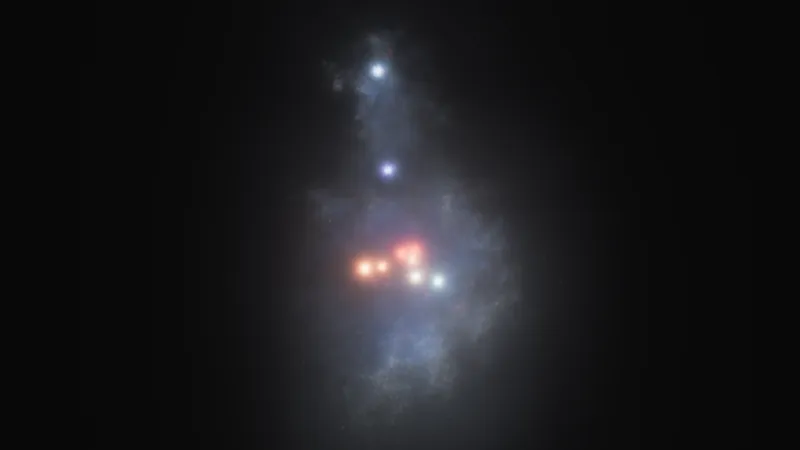
Discover the Firefly Sparkle Galaxy: A Stunning Snapshot of the Milky Way's Youth
2024-12-30
Author: Arjun
Introduction
In an incredible revelation, astronomers have detected a galaxy that offers a fascinating lens into the early days of the Milky Way. Utilizing the groundbreaking technology of the James Webb Space Telescope (JWST) alongside gravitational lensing—a technique where massive objects amplify the light of more distant ones—researchers have identified a lightweight galaxy brimming with star formation from a time when the universe was merely 600 million years old.
Description of the Firefly Sparkle Galaxy
This newly discovered galaxy, whimsically dubbed the Firefly Sparkle Galaxy due to its dazzling array of star clusters, is remarkable not only for its age but also for its size. While most galaxies from this era are typically much more massive, the Firefly Sparkle showcases ten bright star clusters, each with unique characteristics and formations indicative of varied stellar evolution.
Expert Insights
Lamiya Mowla, assistant professor at Wellesley College and a co-lead author of the research, expressed her astonishment at the find. “I didn’t think we would be able to resolve a galaxy that existed so early in the universe into so many distinct components, let alone find its mass to be similar to our own galaxy during its formative period,” she stated. This discovery highlights the dynamic nature of the galaxy, which is still very much undergoing the processes of star formation.
Technological Advances in Observation
The Firefly Sparkle Galaxy was previously captured through observations by both the Hubble Space Telescope and Keck Observatory but gained new insights thanks to the gravitational lensing effect provided by the massive galaxy cluster MACS J1423.8 + 2404. “Without the benefit of this gravitational lens, we would not have been able to resolve this galaxy,” remarked Kartheik Iyer, another co-lead author of the study.
Research Breakthrough
In a groundbreaking paper published in *Nature*, the team devised a model to “undo” the distortions caused by the lensing effect. They found that the original structure of the Firefly Sparkle resembles an elongated raindrop, indicating that its stars have not yet settled into a defined shape typical of mature galaxies.
Stellar Evolution
The stunning visuals presented by the ten distinct star clusters, varying in shades of pink, purple, and blue, reveal that they are in different stages of formation. Each cluster represents a unique chapter in the ongoing story of star evolution, as explained by Chris Willow, principal investigator of the observation program.
Galactic Companions
Adding to the intrigue, the Firefly Sparkle is accompanied by two smaller galaxies, affectionately named Firefly-Best Friend and Firefly-New Best Friend. These proximity companions, located just 6,500 and 42,000 light-years away respectively, play a significant role in stimulating star formation through their gravitational interactions, causing gas within the Firefly Sparkle to condense and cool—a crucial process for galaxy evolution.
Future of the Firefly Sparkle Galaxy
Although the future of the Firefly Sparkle Galaxy remains a mystery, it's expected that, in a few billion years, it may develop characteristics similar to today’s Milky Way, which is now a staggering 10,000 times more massive than it was during that early era. This cosmic journey emphasizes the importance of advanced telescopic technologies and collaborative research in uncovering the mysteries of our universe's evolution.
Conclusion
As astronomers continue to probe the depths of space, similar lightweight galaxies may emerge, offering even more clues about the infancy of the Milky Way and the formation of other galaxies. Keep an eye on the cosmos—what we learn next could illuminate the dawn of our own galactic history!



 Brasil (PT)
Brasil (PT)
 Canada (EN)
Canada (EN)
 Chile (ES)
Chile (ES)
 Česko (CS)
Česko (CS)
 대한민국 (KO)
대한민국 (KO)
 España (ES)
España (ES)
 France (FR)
France (FR)
 Hong Kong (EN)
Hong Kong (EN)
 Italia (IT)
Italia (IT)
 日本 (JA)
日本 (JA)
 Magyarország (HU)
Magyarország (HU)
 Norge (NO)
Norge (NO)
 Polska (PL)
Polska (PL)
 Schweiz (DE)
Schweiz (DE)
 Singapore (EN)
Singapore (EN)
 Sverige (SV)
Sverige (SV)
 Suomi (FI)
Suomi (FI)
 Türkiye (TR)
Türkiye (TR)
 الإمارات العربية المتحدة (AR)
الإمارات العربية المتحدة (AR)